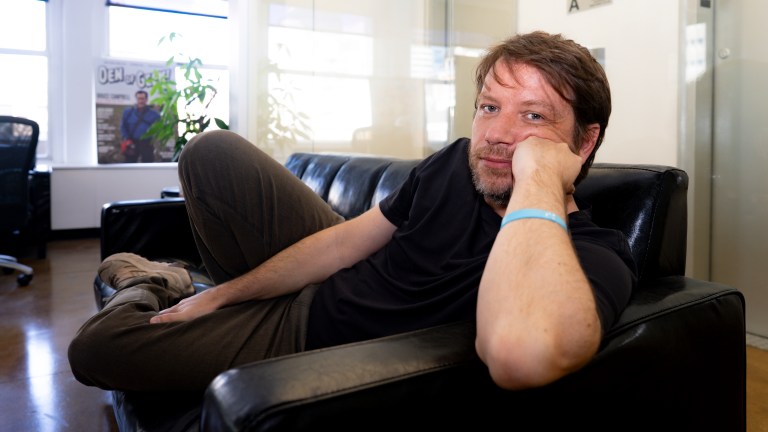Why Quentin Tarantino Calls Gareth Edwards ‘Mr. Purple’
Exclusive: Jurassic World’s Gareth Edwards chats one of his formative moviegoing experiences, Reservoir Dogs, and what happened when he met Quentin Tarantino as a hungry film school kid.

In Gareth Edwards’ mind, it does not get better than Reservoir Dogs. The debut film from Quentin Tarantino which revolutionized indie cinema is also one of those movies you can’t help falling in love with the first time you see it. Actually, the way Edwards tells it, it might have started before that—back when it only existed in the mind’s eye as a handful of clips on film critic Barry Norman’s BBC review series, Film. At the time, Edwards was 16 years old and already transfixed. Going to the theater only affirmed the glory he already knew was to come.
“I wasn’t educated in world cinema and a lot of the exploitation moviemaking that Quentin Tarantino was inspired by,” Edwards explains while stopping by the Den of Geek studio. “It opened a door to a type of filmmaking that I just ignored by being a fan of blockbusters like Star Wars and Spielberg.” In his estimation, Reservoir Dogs even holds “the high score” for the movie he’s seen most in a cinema with seven viewings. (By comparison E.T. and Back to the Future only got three viewings a piece.)
“Reservoir Dogs was seven probably because they wouldn’t release it on video in the UK,” Edwards says, noting how despite the movie making a big splash in the UK, Tarantino’s first film became such a lightning rod of controversy due to its use of violence that it spent years barred from home video VHS. This was because, at the time, the UK government was debating a bill that would require the censors at the BBFC to tighten their rules over what could be released on the home video market, leaving RD in limbo. Ironically it also led to the film spending nearly two full years in movie houses where audiences could see it again and again.
“It was considered a Video Nasty or whatever, because it was gruesome, which I totally disagree with,” says Edwards. “Basically you can have two types of films. You can have a film where there’s a lot of violence, and the character gets back up like nothing happened or doesn’t seem to care, which I think is a bad lesson for kids. Or you can have a film where if you shoot someone in the stomach, they squirm and cry for two hours straight before they die, which I think is a better lesson for guns.”
Be that as it may, it had a profound impact on Edwards’ own adolescence, decades before he would go on to make plenty of blockbuster movies set in the worlds of his own childhood favorites—worlds like Godzilla, Star Wars, and even Jurassic Park, as seen in this holiday weekend’s new release, Jurassic World Rebirth. Yet each of them featured an added sense of gravity and sobriety compared to what came previously. Consider the weight of Ken Watanabe saying “let them fight” in 2014’s Godzilla, or Rogue One being the only Star Wars film where most of the good guys die.
Before any of that, however, Edwards was a kid in the ‘90s who had his mind blown by Tarantino’s first movie. It would also prove serendipitous since before becoming a professional filmmaker, he would get a chance to meet QT in a fateful encounter where young Edwards would be christened… Mr. Purple.
The name should be familiar to anyone who’s seen Reservoir Dogs, a picture where a band of professional criminals get together to do a job. In the film, they’re wisely encouraged not to share their real names, so they instead go by color-coded aliases: Mr. Orange and Mr. White, Mr. Brown and Mr. Blond, and then of course there’s Mr. Pink—a moniker Steve Buscemi’s wiseacre malcontent fights like hell from being called.
“Why am I Mr. Pink?” Buscemi famously whines. “Why not Mr. Purple? That sounds good to me.” The cantankerous answer from his boss is he can’t be Mr. Purple. There’s some other guy on another job who’s Mr. Purple already.
And for a while there in Edwards’ young mind, he was that other guy. At least this was one takeaway from his meeting Tarantino at a Nottingham film festival while in university. At the time, Tarantino had come to town to screen his still quasi-forbidden Reservoir fruit in the UK, but he also was hanging around at cafes, talking shop, and watching any and everything else with a bunch of slackjawed film nerds—including Edwards and his mates.
“I just got in the car and I went up to Nottingham and I just booked tickets for the next movie that was on,” Edwards reminisces with a smile. “It was Le Samourai, this French film, and we were just hanging out in the lobby, and there [Tarantino] was.” By his own sheepish admission, the future Rogue One director was geeky enough to get Tarantino to sign a postcard before Le Samourai started. And afterward, when he and a pal realized there were two seats left open in the auditorium next to the Reservoir Dogs director, it became a battle of wills over who would sit next to QT.
“We were falling down trying to push past each other so we could sit next to Tarantino during this film. But we eventually sat there, and he goes ‘have you guys seen this?’” They hadn’t. “‘Ah you’re going to love it,’ he says. So he introduces the movie, comes and sits back in his seat and then seems to spend the rest of the movie watching our reactions. He just sits there watching our faces, so I was overreacting like ‘OH MY GOD!’ It was a very surreal thing.”
Following the screening, he saw Tarantino one more time that weekend: at the director’s Q&A for Reservoir Dogs. It was also an opportunity to get one more signature.
“I had bought a poster, and I put it down [because] he was signing stuff, and I said, ‘I already got something signed by you ‘to Gareth,’ so I was wondering, could you write something else?’ So he wrote ‘to Mr. Purple, aka Gareth.’ And I’m like ‘I’m officially Mr. Purple!’”
For the next 20 years of Edwards’ life, the poster where QT christened him Mr. Purple held a framed pride of place in his bedroom. It lived there as he finished college; it hung there still after he got his first professional directing jobs on television shows like the 2000s’ Perfect Disaster and Heroes and Villains; and it most definitely was on his wall when Edwards finally got to make his feature debut on a groundbreaking indie that he also wrote and masterminded the special effects for: 2010’s Monsters. In other words, it followed him all the way until he got the chance to meet Tarantino again in LA.
“I ended up having to screen [Monsters] in LA,” Edwards remembers. “I took it to an agency called WME, and they said ‘can you go down there and introduce it?’ So I go down there, and it’s a really nice cinema but quite small. And I go in, and I’m like, ‘Hi, I’m Gareth’ and I start to talk about it.” As he gives his remarks, however, he starts recognizing some familiar faces in the industry: a producer here, a future disgraced executive there… and then there’s Tarantino. Suddenly that old surreal awe came back, and Edwards’ pulse is racing.
“I ended up doing this quick introduction, leaving, running around the back, and going into the projection booth and just watching him the whole movie—watching to see what his reaction was,” says Edwards.
At that moment, he’d come full circle from the time Tarantino was studying some young kid’s face while watching Le Samourai for the first time. Later Edwards was able to go up to Tarantino again, but this time meeting him as a peer instead of a fan. The details of that conversation are a blur, but Edwards is certain that at the end of it, he finally brought up that time QT called him Mr. Purple.
“I said, ‘You actually signed my poster ‘to Mr. Purple,’” Edwards remembers telling him. “And I think, like an idiot, he’s going to remember. ‘Ah, finally, we meet again!’” Tarantino was polite but clearly had no idea what Edwards was talking about.
“He probably wrote ‘to Mr. Purple’ to about 10,000 people,” Edwards laughs now. “It’s like George Lucas writing, ‘The Force is with you.’”
Nonetheless, it was a moment that helped put Edwards on his path to become the filmmaker he is today: the one who made Monsters seem epic on a budget almost comically small (according to The Guardian it cost less than $500,000 to produce), and who would introduce the world to Diego Luna’s Cassian Andor in Rogue One. Even now he’s trying to bring ‘90s blockbuster storytelling back in Jurassic World Rebirth.
“My dream is we make a film that feels like it had been made in the early ‘90s and Universal had forgotten they made it,” Edwards recalls of his initial pitch to the studio. “They had put it on a shelf somewhere, and then like last year, they were just going through their library and they’re like ‘what is this?’ and they blew the dust off and it says ‘Jurassic World Rebirth’ and they go, ‘We don’t remember doing that!’ And they just decide to release it this summer.”
That recovered dino adventure is in theaters now. Meanwhile you can see the rest of our conversation with Edwards about Tarantino, dinosaurs, and Mr. Pink the video interview above.
